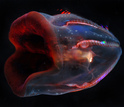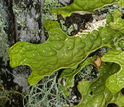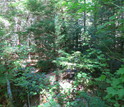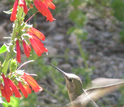Hola amigos: A VUELO DE UN QUINDE EL BLOG., hemos recibido información de la Fundación Nacional de Ciencia de Los Estados Unidos, sobre un premio de U$ 23, millones; que la institución otorga a los trabajos de investigación sobre la vida en la Tierra.
More information...........
Research will fill in knowledge gaps, lead to advances in health, agriculture, energy and manufacturing
 Credit and Larger Version |
Rapid changes are happening in the Arctic: ice cover is shrinking, permafrost is thawing. But what's happening to ground-dwelling species such as mosses?
Mosses are critical parts of nutrient cycles in the far north, scientists say. For example, microbes that live on mosses are the major source of nitrogen for plant growth in boreal and tundra ecosystems. Yet many aspects of these plant communities are poorly understood.
Through a new National Science Foundation (NSF) Dimensions of Biodiversity grant, Stuart McDaniel of the University of Florida and colleagues will use moss-microbe interactions to understand how biodiversity shapes high-latitude ecosystems.
The project is one of 10 funded this year through NSF's Dimensions of Biodiversity Program.
A total of $23 million has been invested in the grants, with contributions from NSF's directorates for Biological Sciences and Geosciences, as well as the National Natural Science Foundation of China (NSFC) and the Sao Paulo Research Foundation of Brazil (FAPESP).
The Dimensions of Biodiversity Program is unique in its approach. In contrast to traditional biodiversity research that focuses on one taxonomic group or ecosystem, Dimensions of Biodiversity integrates multiple areas of study into research projects.
The program links functional, genetic and phylogenetic/taxonomic dimensions of biodiversity, offering opportunities to produce rapid advances in understanding the creation, maintenance and loss of biodiversity.
"This year's Dimensions of Biodiversity investigators join an international and multidisciplinary network of scientists who, through cutting-edge and integrative approaches, are transforming our understanding of biodiversity," says James Olds, assistant director for NSF's Biological Sciences directorate.
The research will fill in gaps in biodiversity knowledge, scientists say. It also has the potential to lead to significant progress in agriculture, fuel, manufacturing and health.
For example, plant and animal extinctions are detrimental to human health, scientists have found. Species losses in ecosystems such as forests and fields result in increases in pathogens, or disease-causing organisms. The species most likely to disappear as biodiversity declines are often those that buffer infectious disease transmission. Those that remain tend to be ones that magnify diseases such as West Nile virus and Lyme disease.
Economic sustainability also depends on the diversity of life on Earth. Many industrial materials, such as fibers and dyes, come from biological sources. In addition, biodiversity is important to such resources as water, food and pharmaceuticals.
To conserve Earth's biodiversity, scientists funded through the Dimensions of Biodiversity program are working to better understand interactions among species from microbes to mosses, lichens and marine life.
"Understanding the diversity of life on land and in the sea is critical as our environment changes," says Roger Wakimoto, assistant director for NSF's Geosciences directorate. "This year's Dimensions of Biodiversity projects include important but poorly known branches of animals and microorganisms in understudied regions of the oceans."
The new Dimensions of Biodiversity projects focus on topics including: the diversity of ctenophores, or comb jellies, in the deep sea; lichens in a global diversity hotspot; microbial communities living on suspended and sinking particles in marine oxygen-deficient zones; moss microbiomes in rapidly changing Alaskan ecosystems; and pollination in Penstemon, or beardtongues, a large genus of North American and East Asian flowering plants.
2015 Dimensions of Biodiversity Awards
Martha Condon, Cornell College: Dimensions: Collaborative Research: Diversification Dynamics of Multitrophic Interactions in Tropical Communities
Peter Girguis, Harvard University:
Dimensions: The phylogenetic and functional diversity of extracellular electron transfer across all three domains of life
Steven Haddock, Monterey Bay Aquarium Research Institute:
Dimensions: Life at extremes: Linking the phylogenetic and genomic diversity of ctenophores to ecophysiological adaptations in the deep sea
Lena Hileman, University of Kansas:
Dimensions: The evolution of pollination syndrome diversity in Penstemon
James Lendemer, New York Botanical Garden:
Dimensions: Biodiversity Gradients in Obligate Symbiotic Organisms: A Case Study in Lichens in a Global Diversity Hotspot
Stuart McDaniel, University of Florida:
Dimensions: Collaborative Research: Community genomic drivers of moss microbiome assembly and function in rapidly changing Alaskan ecosystems
Matthew Olson, Texas Tech University:
Dimensions US-China: Allosomes and dioecy in plants as drivers of multi-level biodiversity
Tammi Richardson, University of South Carolina:
Dimensions: Links Between Spectral Irradiance and Cryptophyte Biodiversity in Environments from Ponds to Oceans
Gabrielle Rocap, University of Washington:
Dimensions: Diversity, assembly and function of microbial communities on suspended and sinking particles in a marine Oxygen Deficient Zone
Brett Tyler, Oregon State University:
Dimensions: Dynamical interactions between plant and oomycete biodiversity in a temperate forest
-NSF-
Media Contacts Cheryl Dybas, NSF, (703) 292-7734, cdybas@nsf.gov
Related WebsitesNSF News (2014 awards): Whither the diversity of life on Earth? NSF, partners award $23 million for studies of planet's biodiversity:
http://www.nsf.gov/news/news_summ.jsp?cntn_id=132506
NSF News (2013 awards):
In race against time, NSF grants fund research on Earth's threatened biodiversity: http://www.nsf.gov/news/news_summ.jsp?cntn_id=129242
NSF News (2012 awards):
Stemming the Tide of Biodiversity Loss on Earth:
http://www.nsf.gov/news/news_summ.jsp?cntn_id=125495&org=NSF&from=news
NSF Discovery: Staple of recipe favorites--the tomato--reveals processes that maintain biodiversity: http://nsf.gov/discoveries/disc_summ.jsp?cntn_id=129676
NSF Discovery: A Stream Is a Stream Is a Stream: Or Is It?: http://www.nsf.gov/discoveries/disc_summ.jsp?cntn_id=123855&org=NSF
The National Science Foundation (NSF) is an independent federal agency that supports fundamental research and education across all fields of science and engineering. In fiscal year (FY) 2015, its budget is $7.3 billion. NSF funds reach all 50 states through grants to nearly 2,000 colleges, universities and other institutions. Each year, NSF receives about 48,000 competitive proposals for funding, and makes about 11,000 new funding awards. NSF also awards about $626 million in professional and service contracts yearly.
Useful NSF Web Sites:
NSF Home Page: http://www.nsf.gov
NSF News: http://www.nsf.gov/news/
For the News Media: http://www.nsf.gov/news/newsroom.jsp
Science and Engineering Statistics: http://www.nsf.gov/statistics/
Awards Searches: http://www.nsf.gov/awardsearch/

This deep-sea ctenophore, or comb jelly, shows the dark red color typical of deep-sea species.
Credit and Larger Version

This ecologically important lichen is indicative of high-quality habitats in eastern North America.
Credit and Larger Version

A parasitic wasp stands on a plant with the common name rainforest cucumber (Gurania costaricensis).
Credit and Larger Version

The Wind River Forest Dynamics Plot in Oregon is a Dimensions of Biodiversity research site.
Credit and Larger Version

The beardtongue plant's red flowers attract hummingbirds.
Credit and Larger Version
The National Science Foundation (NSF)
Guillermo Gonzalo Sánchez Achutegui
ayabaca@gmail.com
ayabaca@hotmail.com
ayabaca@yahoo.com
Inscríbete en el Foro del blog y participa : A Vuelo De Un Quinde - El Foro!

No hay comentarios:
Publicar un comentario